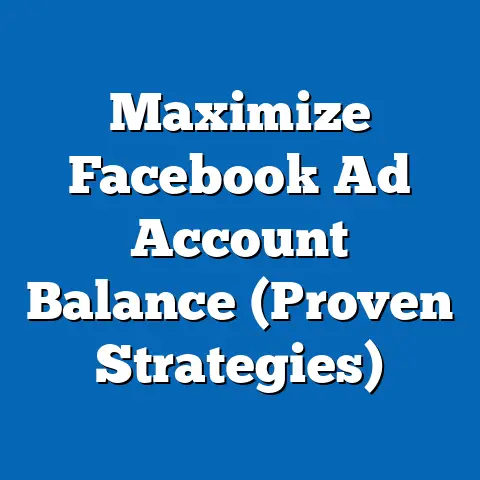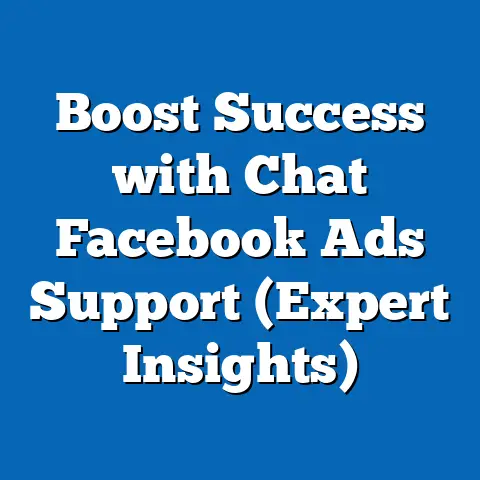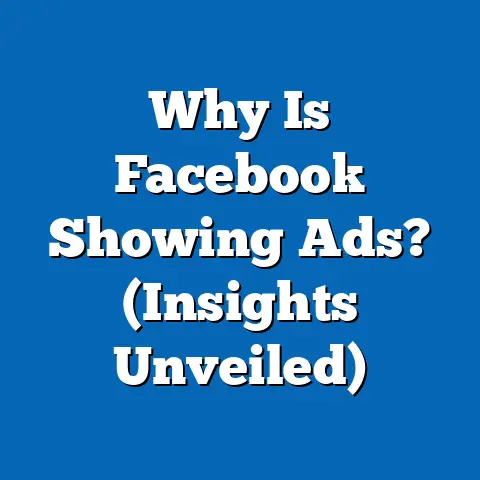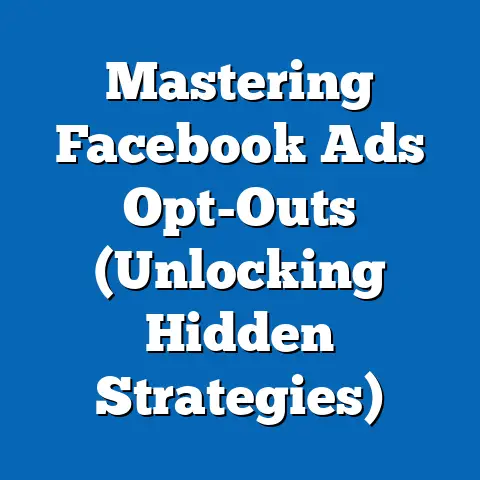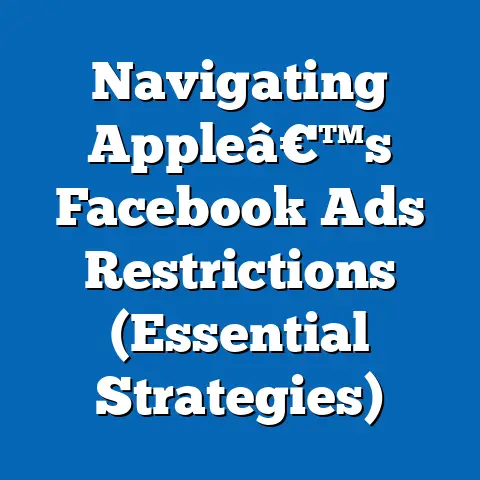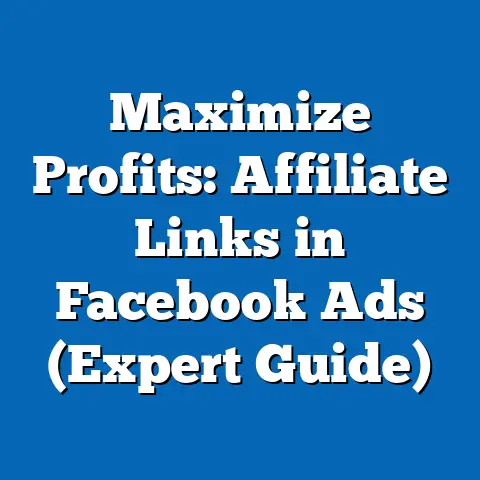Unlocking Facebook Ads Costs in the UK (Expert Insights)
In the rapidly evolving landscape of digital marketing, understanding the true costs associated with Facebook advertising in the UK can feel like deciphering a complex puzzle. With fluctuating rates, diverse target audiences, and varying ad formats, how can businesses effectively budget for their campaigns while maximizing their return on investment?
I’ve been navigating the world of Facebook Ads for over a decade, and believe me, the UK market presents its own unique set of challenges and opportunities. I’ve seen businesses thrive with carefully crafted campaigns and budgets, and others stumble, wasting valuable resources. This guide is designed to help you avoid those pitfalls and unlock the secrets to cost-effective Facebook advertising in the UK.
Overview of Facebook Ads in the UK
Facebook remains a powerhouse in the digital advertising arena, and the UK is no exception. With millions of active users, it provides an unparalleled platform for businesses of all sizes to connect with their target audiences.
- UK Facebook User Statistics: According to Statista, as of early 2024, Facebook has over 44 million users in the UK. This represents a significant portion of the population and makes it an attractive platform for advertisers.
- Relevance for Businesses: The sheer scale of Facebook’s user base in the UK means that almost any business can find a relevant audience on the platform. From local shops targeting specific postcodes to national brands aiming for broad demographic reach, Facebook offers the tools and targeting options to make it happen.
- Strategic Importance: In today’s digital landscape, Facebook Ads shouldn’t be viewed as a standalone tactic but as an integral part of a broader digital marketing strategy. When combined with SEO, email marketing, and other channels, Facebook Ads can amplify your reach and drive significant results.
My Experience: I remember working with a small bakery in London a few years ago. They were struggling to get their name out there. We launched a hyper-local Facebook ad campaign targeting users within a 5-mile radius of their shop, showcasing their delicious pastries and offering a small discount. The result? A massive influx of new customers and a significant boost in sales. This illustrates the power of Facebook Ads when targeted effectively.
Takeaway: Facebook is a powerful advertising platform in the UK due to its vast user base and diverse targeting options. It’s crucial to view it as part of a comprehensive digital marketing strategy.
Understanding Facebook Ads Costs
Before diving into the specifics of the UK market, let’s define some key terms and concepts related to Facebook Ads costs. Understanding these metrics is fundamental to effective budgeting and campaign optimization.
- Cost Per Click (CPC): This is the amount you pay each time someone clicks on your ad. It’s a common metric for campaigns focused on driving traffic to your website or landing page.
- Cost Per Impression (CPM): This is the amount you pay for every 1,000 impressions your ad receives. An impression is counted each time your ad is displayed to a user. CPM is often used for brand awareness campaigns.
- Cost Per Action (CPA): This is the amount you pay for a specific action, such as a purchase, lead generation, or app install. CPA is often the most relevant metric for campaigns focused on driving conversions.
How These Metrics Impact Budgeting:
- CPC: If your primary goal is to drive traffic, understanding your CPC will help you estimate how many clicks you can expect for a given budget. For example, if your CPC is £0.50 and you have a budget of £500, you can expect to receive approximately 1,000 clicks.
- CPM: If your goal is to increase brand awareness, CPM will help you estimate how many people you can reach with your ad. For example, if your CPM is £5 and you have a budget of £500, you can reach approximately 100,000 people (500/5 * 1000).
- CPA: If your goal is to drive conversions, CPA is the most important metric to track. It tells you how much you’re paying for each desired action. For example, if your CPA is £20 and you want to generate 50 leads, you’ll need a budget of £1,000.
Cost Variation Based on Objectives:
- Brand Awareness: Campaigns focused on brand awareness typically have lower CPCs and CPMs, as the goal is simply to get your ad in front of as many people as possible.
- Traffic: Campaigns focused on driving traffic tend to have moderate CPCs, as you’re targeting users who are likely to click on your ad.
- Lead Generation: Campaigns focused on lead generation often have higher CPAs, as you’re targeting users who are likely to provide their contact information.
- Conversions: Campaigns focused on driving sales or other conversions typically have the highest CPAs, as you’re targeting users who are ready to make a purchase.
My Insight: I’ve found that many businesses make the mistake of focusing solely on one metric, such as CPC, without considering the overall cost per acquisition (CPA). It’s essential to track all relevant metrics and optimize your campaigns based on your specific business goals.
Takeaway: Understanding CPC, CPM, and CPA is crucial for effective budgeting and campaign optimization. Costs can vary significantly based on your advertising objectives, so it’s important to align your budget with your goals.
Factors Influencing Facebook Ads Costs in the UK
Several factors can significantly influence the cost of Facebook Ads in the UK. Understanding these factors will allow you to make more informed decisions about your targeting, bidding, and ad creative.
- Audience Targeting Options:
- Demographics: Targeting options such as age, gender, location, and education level can impact costs. Highly specific demographic targeting can lead to higher costs due to a smaller audience size.
- Interests: Targeting users based on their interests and hobbies can also affect costs. Popular interests may be more competitive, leading to higher CPMs and CPCs.
- Behaviors: Targeting users based on their online behavior, such as purchase history or website visits, can be effective but may also be more expensive.
- Lookalike Audiences: Creating lookalike audiences based on your existing customers can be a cost-effective way to reach new prospects who are similar to your best customers.
- Competition Within the Industry and Bidding Strategies:
- Industry Competition: Industries with high levels of competition, such as e-commerce and finance, tend to have higher ad costs. This is because more businesses are bidding on the same keywords and targeting the same audiences.
- Bidding Strategies: Facebook offers various bidding strategies, including automatic bidding, cost cap bidding, and manual bidding. Your choice of bidding strategy can significantly impact your ad costs.
- Auction Dynamics: Facebook Ads operate on an auction system. The more advertisers competing for the same audience, the higher the costs will be.
- Seasonal Trends and Market Fluctuations:
- Seasonal Peaks: Ad costs tend to increase during peak seasons, such as Christmas and Black Friday, due to increased competition.
- Economic Factors: Economic factors, such as inflation and consumer spending, can also impact ad costs.
- Market Events: Major events, such as sporting events or political elections, can also affect ad costs due to increased advertising activity.
- Ad Quality and Relevance Score:
- Ad Quality: Facebook evaluates the quality of your ads based on factors such as visual appeal, clarity of messaging, and user experience.
- Relevance Score: Your relevance score is a metric that indicates how well your ad resonates with your target audience. A higher relevance score can lead to lower ad costs and better performance.
- User Feedback: Negative feedback from users, such as hiding your ad or reporting it as spam, can negatively impact your relevance score and increase your ad costs.
- Demographics: Targeting options such as age, gender, location, and education level can impact costs. Highly specific demographic targeting can lead to higher costs due to a smaller audience size.
- Interests: Targeting users based on their interests and hobbies can also affect costs. Popular interests may be more competitive, leading to higher CPMs and CPCs.
- Behaviors: Targeting users based on their online behavior, such as purchase history or website visits, can be effective but may also be more expensive.
- Lookalike Audiences: Creating lookalike audiences based on your existing customers can be a cost-effective way to reach new prospects who are similar to your best customers.
- Industry Competition: Industries with high levels of competition, such as e-commerce and finance, tend to have higher ad costs. This is because more businesses are bidding on the same keywords and targeting the same audiences.
- Bidding Strategies: Facebook offers various bidding strategies, including automatic bidding, cost cap bidding, and manual bidding. Your choice of bidding strategy can significantly impact your ad costs.
- Auction Dynamics: Facebook Ads operate on an auction system. The more advertisers competing for the same audience, the higher the costs will be.
- Seasonal Peaks: Ad costs tend to increase during peak seasons, such as Christmas and Black Friday, due to increased competition.
- Economic Factors: Economic factors, such as inflation and consumer spending, can also impact ad costs.
- Market Events: Major events, such as sporting events or political elections, can also affect ad costs due to increased advertising activity.
- Ad Quality: Facebook evaluates the quality of your ads based on factors such as visual appeal, clarity of messaging, and user experience.
- Relevance Score: Your relevance score is a metric that indicates how well your ad resonates with your target audience. A higher relevance score can lead to lower ad costs and better performance.
- User Feedback: Negative feedback from users, such as hiding your ad or reporting it as spam, can negatively impact your relevance score and increase your ad costs.
Expert Insight from UK Digital Marketing Professionals:
I spoke with Sarah Jones, a digital marketing consultant based in London, about her experience with Facebook ad costs in the UK. “I’ve noticed that hyper-local targeting can be incredibly effective but also surprisingly expensive. It really pays to A/B test different ad creatives and targeting options to find the sweet spot between cost and performance,” she said.
Another expert, Mark Williams, a PPC specialist in Manchester, added, “The biggest mistake I see businesses make is setting their budget and forgetting about it. Facebook Ads require constant monitoring and optimization. You need to be proactive in adjusting your bidding strategies and refining your targeting based on the data you’re seeing.”
My Experience: I once worked with a travel company targeting users interested in adventure holidays. Initially, their ad costs were quite high. By refining their targeting to include specific adventure activities and destinations, and by creating more engaging ad creatives that resonated with their target audience, we were able to significantly reduce their costs while improving their conversion rate.
Takeaway: Several factors influence Facebook Ads costs in the UK, including audience targeting, competition, seasonal trends, and ad quality. By understanding these factors and implementing best practices, you can optimize your campaigns and reduce your costs.
Case Studies of Successful Facebook Ad Campaigns
Analyzing real-world examples of successful Facebook ad campaigns in the UK can provide valuable insights into how to navigate costs and achieve significant results. Here are a few case studies that highlight effective strategies.
Case Study 1: Local Restaurant in Bristol
- Challenge: A local restaurant in Bristol wanted to increase its lunchtime foot traffic.
- Strategy: They launched a hyper-local Facebook ad campaign targeting users within a 2-mile radius of their restaurant, offering a special lunchtime discount.
- Results: They saw a 30% increase in lunchtime customers and a significant boost in revenue.
- Lessons Learned: Hyper-local targeting can be incredibly effective for businesses with a physical location. Offering a compelling incentive, such as a discount, can drive immediate results.
Case Study 2: E-commerce Fashion Brand
- Challenge: An e-commerce fashion brand wanted to increase its online sales.
- Strategy: They launched a Facebook ad campaign targeting users interested in fashion and style, using high-quality images and videos of their products.
- Results: They saw a 50% increase in online sales and a significant improvement in their return on ad spend (ROAS).
- Lessons Learned: High-quality visuals are essential for e-commerce advertising. Targeting users based on their interests can drive relevant traffic to your website.
Case Study 3: Tech Startup Promoting a Mobile App
- Challenge: A tech startup wanted to increase downloads of its mobile app.
- Strategy: They launched a Facebook ad campaign targeting users interested in technology and mobile apps, using compelling ad copy and a clear call to action.
- Results: They saw a 100% increase in app downloads and a significant improvement in their cost per install (CPI).
- Lessons Learned: A clear call to action is crucial for driving app downloads. Targeting users based on their interests and demographics can improve your CPI.
Case Study 4: Charity Raising Awareness for a Cause
- Challenge: A UK-based charity wanted to raise awareness for a specific cause and solicit donations.
- Strategy: They ran a Facebook campaign sharing impactful stories and visuals related to their cause, targeting users interested in social issues and charitable giving. They used a direct “Donate Now” call-to-action.
- Results: They saw a significant increase in donations, as well as a rise in overall awareness and engagement with their mission.
- Lessons Learned: Emotionally resonant content can be highly effective for non-profit organizations. Clear calls-to-action are critical for converting awareness into tangible support.
My Insight: What I’ve noticed across successful campaigns is a relentless focus on understanding the target audience. It’s not enough to just know their demographics; you need to understand their motivations, pain points, and what truly resonates with them.
Takeaway: These case studies demonstrate that successful Facebook ad campaigns require a clear understanding of your target audience, compelling ad creatives, and a well-defined strategy. By learning from these examples, you can optimize your own campaigns and achieve significant results.
Common Pitfalls and Mistakes to Avoid
While Facebook Ads offer tremendous potential, it’s easy to make mistakes that can lead to wasted ad spend and poor results. Here are some common pitfalls to avoid.
- Underestimating Costs:
- Hidden Fees: Don’t forget to factor in potential hidden fees, such as VAT and currency conversion charges.
- Testing Budgets: Allocate a portion of your budget for testing different ad creatives and targeting options.
- Scalability: Be prepared to increase your budget as your campaigns become more successful.
- Failing to Test Different Ad Creatives and Formats:
- A/B Testing: Regularly A/B test different ad creatives, including images, videos, and ad copy, to identify what resonates best with your target audience.
- Ad Formats: Experiment with different ad formats, such as single image ads, carousel ads, and video ads, to see what performs best for your business.
- Placement Testing: Facebook offers various ad placements, including the Facebook feed, Instagram feed, and Audience Network. Test different placements to see where you get the best results.
- Ignoring Audience Insights and Engagement Metrics:
- Audience Insights: Use Facebook’s Audience Insights tool to gain a deeper understanding of your target audience, including their demographics, interests, and behaviors.
- Engagement Metrics: Track engagement metrics such as likes, comments, shares, and click-through rates to see how your ads are performing.
- Feedback Loop: Use audience insights and engagement metrics to continuously refine your targeting and ad creatives.
- Neglecting Mobile Optimization:
- Mobile-First Approach: With the majority of Facebook users accessing the platform on mobile devices, it’s essential to adopt a mobile-first approach to your ad design.
- Mobile-Friendly Landing Pages: Ensure that your landing pages are optimized for mobile devices to provide a seamless user experience.
- Setting and Forgetting Budgets:
- Continuous Monitoring: Don’t just set your budget and forget about it. Continuously monitor your campaigns and make adjustments as needed.
- Automated Rules: Set up automated rules to pause or adjust your campaigns based on specific performance metrics.
- Hidden Fees: Don’t forget to factor in potential hidden fees, such as VAT and currency conversion charges.
- Testing Budgets: Allocate a portion of your budget for testing different ad creatives and targeting options.
- Scalability: Be prepared to increase your budget as your campaigns become more successful.
- A/B Testing: Regularly A/B test different ad creatives, including images, videos, and ad copy, to identify what resonates best with your target audience.
- Ad Formats: Experiment with different ad formats, such as single image ads, carousel ads, and video ads, to see what performs best for your business.
- Placement Testing: Facebook offers various ad placements, including the Facebook feed, Instagram feed, and Audience Network. Test different placements to see where you get the best results.
- Audience Insights: Use Facebook’s Audience Insights tool to gain a deeper understanding of your target audience, including their demographics, interests, and behaviors.
- Engagement Metrics: Track engagement metrics such as likes, comments, shares, and click-through rates to see how your ads are performing.
- Feedback Loop: Use audience insights and engagement metrics to continuously refine your targeting and ad creatives.
- Mobile-First Approach: With the majority of Facebook users accessing the platform on mobile devices, it’s essential to adopt a mobile-first approach to your ad design.
- Mobile-Friendly Landing Pages: Ensure that your landing pages are optimized for mobile devices to provide a seamless user experience.
- Continuous Monitoring: Don’t just set your budget and forget about it. Continuously monitor your campaigns and make adjustments as needed.
- Automated Rules: Set up automated rules to pause or adjust your campaigns based on specific performance metrics.
Expert Commentary:
According to Liam Green, a Facebook Ads specialist in Birmingham, “One of the biggest mistakes I see is businesses not tracking their conversions properly. If you’re not tracking your conversions, you have no way of knowing whether your ads are actually driving results. Make sure you have Facebook Pixel installed correctly and that you’re tracking all relevant conversion events.”
My Experience: I once worked with a client who was spending a significant amount of money on Facebook Ads but wasn’t seeing any results. After digging deeper, I discovered that they hadn’t installed the Facebook Pixel on their website. As a result, they weren’t tracking conversions and had no idea which ads were actually driving sales. Once we installed the Pixel and started tracking conversions, we were able to optimize their campaigns and significantly improve their ROAS.
Takeaway: Avoiding these common pitfalls is crucial for maximizing your return on investment with Facebook Ads. By tracking your conversions, testing different ad creatives, and continuously monitoring your campaigns, you can avoid wasting ad spend and achieve significant results.
Expert Insights and Predictions for the Future
The landscape of Facebook advertising is constantly evolving, with new features, algorithms, and trends emerging all the time. To stay ahead of the curve, it’s essential to stay informed about the latest developments and anticipate future changes.
- Anticipated Changes in Ad Pricing Structures:
- AI-Powered Bidding: Facebook is increasingly using AI to optimize bidding strategies. Expect to see more sophisticated AI-powered bidding options in the future.
- Value-Based Bidding: Facebook is also moving towards value-based bidding, where advertisers bid based on the predicted value of each conversion.
- Platform Features:
- Augmented Reality (AR) Ads: AR ads are becoming increasingly popular, allowing users to interact with your products in a virtual environment.
- Interactive Ads: Expect to see more interactive ad formats, such as polls, quizzes, and games, that encourage user engagement.
- Audience Behavior:
- Privacy Concerns: Privacy concerns are growing among users, leading to increased demand for data privacy and control.
- Mobile Dominance: Mobile devices will continue to dominate Facebook usage, making mobile optimization even more important.
- The Rise of Video:
- Short-Form Video: Platforms like TikTok and Instagram Reels have popularized short-form video. Adapting to this trend is crucial.
- Live Video: Live videos can generate high engagement. Consider using Facebook Live for Q&A sessions, product demos, or behind-the-scenes content.
- The Metaverse and Facebook Ads:
- Virtual Reality Advertising: As the metaverse develops, we may see new advertising opportunities within virtual reality environments.
- Digital Avatars: Brands might use digital avatars to interact with customers in the metaverse.
- AI-Powered Bidding: Facebook is increasingly using AI to optimize bidding strategies. Expect to see more sophisticated AI-powered bidding options in the future.
- Value-Based Bidding: Facebook is also moving towards value-based bidding, where advertisers bid based on the predicted value of each conversion.
- Augmented Reality (AR) Ads: AR ads are becoming increasingly popular, allowing users to interact with your products in a virtual environment.
- Interactive Ads: Expect to see more interactive ad formats, such as polls, quizzes, and games, that encourage user engagement.
- Privacy Concerns: Privacy concerns are growing among users, leading to increased demand for data privacy and control.
- Mobile Dominance: Mobile devices will continue to dominate Facebook usage, making mobile optimization even more important.
- Short-Form Video: Platforms like TikTok and Instagram Reels have popularized short-form video. Adapting to this trend is crucial.
- Live Video: Live videos can generate high engagement. Consider using Facebook Live for Q&A sessions, product demos, or behind-the-scenes content.
- Virtual Reality Advertising: As the metaverse develops, we may see new advertising opportunities within virtual reality environments.
- Digital Avatars: Brands might use digital avatars to interact with customers in the metaverse.
Expert Insight:
I recently attended a digital marketing conference in London, where I had the opportunity to speak with several industry experts about the future of Facebook advertising. According to one expert, “The biggest trend we’re seeing is the shift towards personalized advertising. Users are demanding more relevant and engaging ads, and Facebook is responding by giving advertisers more tools to target their audiences with greater precision.”
Another expert added, “The key to success in the future will be data-driven decision-making. Advertisers need to be constantly analyzing their data and using it to optimize their campaigns. Those who don’t will be left behind.”
My Prediction: I believe that AI will play an increasingly important role in Facebook advertising in the years to come. AI-powered tools will help advertisers to automate their campaigns, optimize their bidding strategies, and create more personalized ads.
Takeaway: The future of Facebook advertising is likely to be characterized by increased personalization, AI-powered automation, and a focus on data-driven decision-making. By staying informed about these trends and adapting your strategies accordingly, you can stay ahead of the curve and achieve continued success with Facebook Ads.
Wrapping it Up
Understanding Facebook ad costs in the UK is not just about knowing the numbers; it’s about understanding the dynamics of the market, the behavior of your audience, and the ever-changing landscape of the platform itself. It requires a blend of strategic thinking, data analysis, and creative execution.
- Key Points to Remember:
- Facebook remains a powerful advertising platform in the UK, but costs can vary significantly based on several factors.
- Understanding CPC, CPM, and CPA is crucial for effective budgeting and campaign optimization.
- Factors influencing Facebook Ads costs include audience targeting, competition, seasonal trends, and ad quality.
- Successful Facebook ad campaigns require a clear understanding of your target audience, compelling ad creatives, and a well-defined strategy.
- Avoiding common pitfalls, such as underestimating costs and ignoring audience insights, is crucial for maximizing your return on investment.
- The future of Facebook advertising is likely to be characterized by increased personalization, AI-powered automation, and a focus on data-driven decision-making.
- Importance of Comprehensive Digital Marketing Strategy:
- Facebook Ads should be viewed as part of a broader digital marketing strategy, integrated with SEO, email marketing, and other channels.
- A comprehensive strategy allows you to amplify your reach, drive more traffic, and generate more leads.
- Staying Informed and Agile:
- The landscape of Facebook advertising is constantly evolving, so it’s essential to stay informed about the latest developments.
- Be prepared to adapt your strategies as needed to respond to changes in the market and on the platform.
- Facebook remains a powerful advertising platform in the UK, but costs can vary significantly based on several factors.
- Understanding CPC, CPM, and CPA is crucial for effective budgeting and campaign optimization.
- Factors influencing Facebook Ads costs include audience targeting, competition, seasonal trends, and ad quality.
- Successful Facebook ad campaigns require a clear understanding of your target audience, compelling ad creatives, and a well-defined strategy.
- Avoiding common pitfalls, such as underestimating costs and ignoring audience insights, is crucial for maximizing your return on investment.
- The future of Facebook advertising is likely to be characterized by increased personalization, AI-powered automation, and a focus on data-driven decision-making.
- Facebook Ads should be viewed as part of a broader digital marketing strategy, integrated with SEO, email marketing, and other channels.
- A comprehensive strategy allows you to amplify your reach, drive more traffic, and generate more leads.
- The landscape of Facebook advertising is constantly evolving, so it’s essential to stay informed about the latest developments.
- Be prepared to adapt your strategies as needed to respond to changes in the market and on the platform.
My Final Thought: Think of your Facebook ad campaigns as an ongoing experiment. Continuously test, analyze, and refine your strategies based on the data you’re seeing. Don’t be afraid to try new things and to learn from your mistakes.
Takeaway: Understanding Facebook ad costs is essential for effective digital marketing in the UK. By staying informed, agile, and data-driven, you can navigate the complexities of the platform and achieve significant results.
Call to Action
Now it’s your turn! I’d love to hear about your experiences with Facebook Ads in the UK. What challenges have you faced? What strategies have worked well for you? Share your thoughts and insights in the comments below. Let’s learn from each other and help each other succeed in the world of Facebook advertising!

